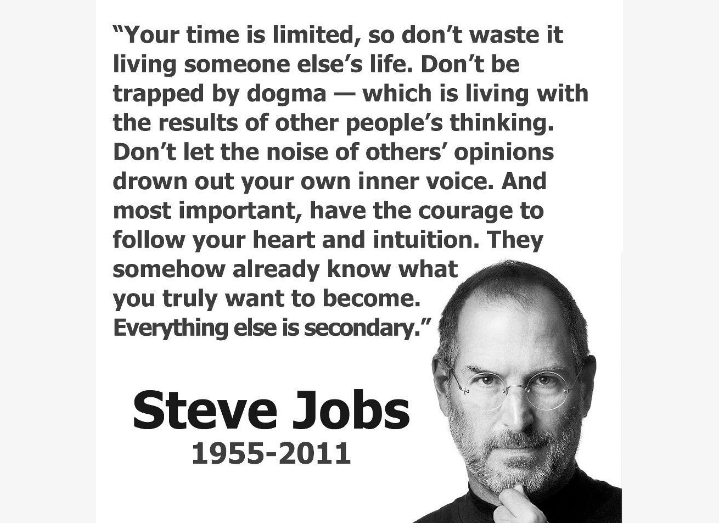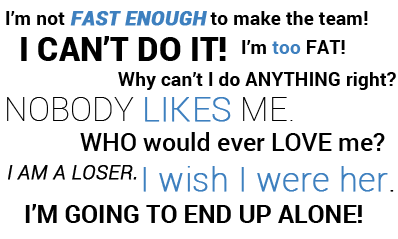corporate leadership
Goal Setting Basics: 4 Words That Sabotage Goals
The Inner Critic is a concept that psychologists use to refer to that inner voice that attacks a person, saying that he or she is bad, wrong, stupid, worthless, and so on. And it loves to show up right when you’re trying to accomplish your most important goals. It tells you that you are going to fail. And oftentimes it succeeds – simply because you choose to believe those negative thoughts.
The voice of this Inner Critic is nothing more than a thought. And the average person has about 50 thoughts per minute! These ideas or opinions are produced by thinking or just suddenly occurring in our mind. They can be about anything… from a memory of our last vacation, a joke we heard on TV, a doubt about our life, or even a fierce dragon! Your Inner Critic LOVES to hold on to certain negative thoughts, and accepts them as true – even when there’s not one shred of proof to back it up – that’s when these thoughts transform into beliefs.
Remember: Just since we believe something, it doesn’t make it true. Heck, people used to believe the Earth was the center of the universe until scholars took a good look and proved them wrong.
When setting goals, a good place to silence the Inner Critic is with our words.
Ever tell a lie? Of course you have. Ever tell a lie so many times that one day you caught yourself thinking that the lie was the truth. That’s because the words we speak reinforce your beliefs.
When we say our negative thoughts out loud, we reinforce those beliefs which keep us from taking action and eventually lead us to failure.
However, when we transform those thoughts into positive statements, we force our Inner Critic to listen and change the things it tells us.
Here are 4 Negative Words we can avoid when speaking about our goals and the 4 Positive Words we should use to replace them:
#1 – “TRY”
TRY is one of the most useless words ever. It’s the word we use when we intend to fail.
What did our old pal YODA say about the word try? That’s right!
“DO or DO NOT – There is no try.”
#2 – “CAN’T”
CAN’T is such a final word. It instantly tells your Inner Critic that all possibility of success is gone.
Which is just so sad! Especially, since most of the time when someone says CAN’T – they usually mean WON’T.
If you wan’t to set forth on a positive track, substitute the word CAN’T with CAN!
#3 – “WHY”
Your Inner Critic is always looking for an excuse to butt-in and give an opinion.
It likes nothing better than to tell you you’re not good enough and seeks to talk you out of your goals.
When you say the word: “WHY” – you’re giving your Inner Critic a direct invitation to jump in and fill in the blanks for you.
When we feel desperate or helpless it often comes out as “WHY ME?”
When doubt enters your mind, replace WHY with HOW.
When you ask: “WHY CAN’T I FIND A JOB?” – Your Inner Critic comes up with all sorts of negative answers that psyche you out!
Instead ask: “HOW AM I GOING TO DO THINGS DIFFERENT TO FIND THE CAREER THAT’S WAITING FOR ME?”
And instead of asking: “WHY AM I DOING SO BAD IN SCHOOL?”
Assign your creativity to work on: “HOW AM I GOING TO ARRANGE MY SCHEDULE TO ALLOW ME TO STUDY MORE?”
See how it forces your Inner Critic to use its efforts more efficiently? You challenge it to come up with a solution to your goal rather than knock it down.
#4 – “DON’T”
Human beings tend to gravitate toward the direction in which we are focused. When we get wrapped up in thinking and talking about the things we don’t want to have happen in our lives, we take away our focus from the things we do want.
It’s the first quality any goal needs to succeed. I talk about it in a past post: How To Set Goals | Quality #1: Make Your Goals Positive!
Focus your goals on the positive with words like: I WILL or I WANT or I AM!
ONE LAST THOUGHT ON NEGATIVE SELF-TALK & CONQUERING THE INNER CRITIC:
There are so many ways that our Inner Critic can make us struggle with the person we were born to be. Check out this video created by ALWAYS.
They have launched a campaign to help young women eliminate negative words from their lives.
When I watched it, it made me re-think everything that comes out of my mouth. Let me know what you think.
Has your Inner Critic ever kept you from getting what you want? Do you have any tips on how to keep positive when self doubt starts to interfere with your goals. We want to know! Please share your ideas with us in the comments section below.
A Guide to Goal Setting
Be it professional, academic, or personal, effective goal setting is easier said than done. Your goals can only turn into reality, if they were set correctly in the first place. Before you embark on setting your life goals, read through this guide to ensure you’re your goals are set in the right direction.
Determine what your goals should be.
Do this by allowing some time for contemplation, and thinking what is important to you. Brainstorm and list down all the things and targets you would want to achieve and eventually shortlist the most important ones.
Set your goals to be high in quality, not quantity.
Having a list of 20+ goals may not only be overwhelming to look at, but holds a higher chance to demotivate and slack you. To ensure accomplishing them, focus on the most important of your goals, which should ideally be 5-7 in number and be concise enough to be stored in your memory.
Make sure your goal setting is S.M.A.R.T.
That being said, S.M.A.R.T. goals refer to goals that are:
Specific:
To make your goals turn into reality, you need to identify what you exactly need to accomplish and set a course of action accordingly. Be as specific and unambiguous as you can when setting your goals, for example, ‘travel and explore’ may be too wide and vague a goal, but narrowing it down to ‘Travel and explore the historical cities of Europe’ may add some direction and precision to it.
Measurable:
Having a measurable goal is necessary to be able to track your progress and decide on future strategies to move towards it. If you wish to buy your own apartment worth $20,000, a measurable goal would be to save $5000 each year for four years and break it down into monthly savings to enable you to plan your expenses and keep an account of your savings.
Achievable:
Let your goals start with an action verb to make them attainable. Instead of formulating a goal to ‘be more consistent in Math grades’, make it more achievable by rephrasing it as ‘Solve two sample papers each week to obtain better grades in Math’
Realistic:
While an ambitious goal setting should call for getting out of your comfort zone and aiming high, one has to ensure that the goals are sensible and practical. Aiming to reach the top ten employees in your first month at work may prove to be too imaginative, work towards improving your productivity and getting a name under notable achievements for the month instead.
Time-constrained:
While “I will lose 20 pounds” maybe achievable and measurable, it does not provide a time limit to achieve. Planning to lose 20 pounds in four months makes the goal time bound and dividable into smaller monthly goals, hence making it more specific and reachable.
Write them down and review them frequently.
Once you have your goals written down, you have half the action plan to achieve them. Writing your goals down reassures you of your intention to make them happen and sets things in motion. A written goal also serves as an effective reminder and progress tracker. Review your goals regularly and evaluate your current progress towards achieving it, and determine your next steps to move towards them. It depends on your individual preference to review them daily, weekly or monthly, but make sure to keep yourself inspired, motivated and well-reminded of your objectives.
Avoid going public with your goals.
Remember they are your goals and should remain personal to you. No one else can associate the same feelings of enthusiasm, dedication and commitment to your goals. Unless you think that sharing them with a certain person, an expert, mentor, business partner or group leader, for example, may help you achieve your goals, avoid sharing them with others as it may make them less likely to materialize.
How To Set Goals | Goal Setting Fundamentals
“A leader is one who knows the way, goes the way, and shows the way.”
— John C. Maxwell
⇒ Leaders Set Goals
Do you consider yourself a leader?
Sometimes we associate leaders with high-profile, powerful positions.
• The CEO of a Company.
• The Principal of a School.
• The President of the United States
And yes, these people are leaders. But you don’t have to be rich, famous, or powerful to be a leader. You just need to be a person who leads.
Leaders are needed in all areas of life — in families, amongst friends, on teams, in the workplace, and on campus.
They’re the ones that open doors for others to follow and set the standards by which we live.
Leaders can possess a variety of different characteristics and personality traits. They might be driven, intelligent, creative, hard-working, charismatic, or even domineering. But the similarity that one can find amongst almost every leader… THEY HAVE GOALS!
“You can practice shooting eight hours a day, but if your technique is wrong, then all you become is very good at shooting the wrong way. Get the fundamentals down and the level of everything you do will rise.”
—Michael Jordan
⇒ Fundamentals of Effective Goal Setting
In goal setting, technique is everything!
When I hear people explain that they are having trouble with accomplishing their goals, it is usually because they started off wrong from the beginning. They had bad goals. I don’t mean the things they wanted were bad. It’s just that they didn’t set their goals up for success.
A goal is more likely to be accomplished if it’s designed with these qualities in mind:
1. YOUR GOAL MUST BE POSITIVE
2. YOUR GOAL MUST BE SPECIFIC
3. YOUR GOAL MUST BE REACHABLE
4. YOUR GOAL MUST BE PERSONAL
If your goal doesn’t satisfy these four requirements, you might run into some trouble along the way. Over the next few posts, we’ll take a closer look at these characteristics that differentiate a good goal from a bad goal.
NEXT UP: How To Set Goals Quality #1: Make Your Goal Positive
Do you have any favorite goal-setting lessons, quotes, games, or activities that you use to teach goal-setting? Maybe you know a great tip to help eager goal-setters reach their goals faster? Leave your comments below!
I look forward to a great goal-setting discussion!
Team Building Games and Activities
Be it a soccer match, a classroom project, or a business deal, it is only as successful as the team behind it is. Having a strong team with ambitious team leaders, cooperative members, and an undying team spirit not only keeps the members motivated and interactive, but it also breaks the barriers between mindsets to promote their creativity and problem-solving skills. Benefit from the following team builders in order to get involved into exciting and interactive team building exercises within your group.
Consensus
An excellent exercise aimed at team building and teamwork, Consensus promotes the importance of unity, agreement and compromise among all team members. This team builder can be especially effective in school trainings or student leadership sessions.
Easy to execute, without any material or space requirements, the activity requires all participants to split up into smaller groups of 5-6 people and cluster together to agree on a particular noise and action to perform for other teams. Once each group has demonstrated their act twice, the facilitator should allow them to huddle once again to recall all groups’ acts, and prepare themselves for a collective performance of with all the teams. This activity holds an objective for all the teams to keep regrouping, and repetitively attempt a collective act to ultimately do the same noise and action together, without any consultation between the teams.
After the activity, discuss and debrief the participants on their difficulties to reach a consensus, whether they needed any leadership intervention, their frustrations due to the communication barriers between teams, and any compromises that they had to make to reach an undivided final outcome.
Walk Together
As the name suggests, this activity requires all team members to walk together, but with their ankles tied to each others’. An idyllic team builder for building group trust, team cooperation and problem solving skills, a Walk Together activity works best for both students and employees.
Owing to its mobile nature, it is best to employ this team building activity in open spaces without any obstacles. Start by splitting a large group into smaller ones with no more than eight people each. While cloth strips or masking tape may be ideal, you may simply ask the participants to use their shoe laces to tie their ankles to both their neighbors’. The idea is to challenge the whole team to devise a strategy, coordinate with each other, and trust each other’s instincts to successfully walk together towards the finishing line, without any team member falling.
Once you have a winning team, gather all participants to discuss how they felt about their teammates during the activity, whether they helped or hindered each other’s progress, and what kind of collective effort and cooperation was required to be successful at the task.
Scavenger Hunt
An immensely proactive and competitive team challenge, scavenger hunts are timeless classics among team builders. The material and space requirements are individualized; however scavenger hunts are mostly carried out in several locations due to the ‘hunting process.’ Facilitators and trainers devise a plan where participants are split into groups and each group is handed a list of tasks to accomplish in a limited time span and under some specific rules and conditions. Teams are given points on their achievements, punctuality and penalized for any rule violations. Scavenger hunts have proven, time and again, to be a very sporty and exciting way to promote leadership skills, team bonding, team work planning, and coordination among the members.
Public Speaking 101
Your purpose is to make your audience see what you saw, hear what you heard, feel what you felt. Relevant detail, couched in concrete, colorful language, is the best way to recreate the incident as it happened and to picture it for the audience – Dale Carnegie
If facing a large audience gives you shivers, and the thought of public speaking gives you pangs of nervousness, make sure to follow these basic guidelines before you prepare for your next public speech or presentation.
Make the introduction gripping, and the content clear and concise
The content of your speech is the backbone of your success. Remember that first impressions are the last ones too, and aim to capture the attention of your listeners with your first expression. Starting with an inspirational quote, or a relevant short story, may work well to grip an audience. Ryan McLean highlights the importance of a captivating beginning by saying, “Your introduction needs to establish with the audience why it is important to them and why they should be listening to the speech.”
That being said, the quality of the main body is equally essential to ensure a successful outcome. The success of your presentation will be judged not by the knowledge you send out, but by what the listeners grasp from your words. Be understandable and assertive on your viewpoints; make sure you speak slowly, clearly, and thoughtfully. Keep the content to the point, avoid beating about the bush, and keep in mind the difference between a lecture and a speech. When determining the length of your content, take a hint from Dorothy Sarnoff’s advice, “Make sure you have finished speaking before your audience has finished listening.”
Confidence, composure, and poise
Undoubtedly, the most feared words of public speaking. You may be trying your best to avoid eye contact or imagining there is no one in the room, but as dreaded as it is, eye contact and speaking with confidence is extremely vital for an exceptional public act. It is absolutely vital for a public speaker to know the difference between ‘public reading’ and ‘public speaking’. Your audience is not there to watch your head hanging down as you read from a piece of paper. Make sure to be well-dressed, keep your hands out of your pocket, and stand tall and erect without moving a lot.
Public speaking is only 10% what you deliver and 90% how you deliver. Make sure you have researched well on your facts and figures, and confidently convey it to your listeners to make them believe in your potential and credibility. Keep it engaging and smooth by focusing your gaze on the audience as you speak and redirecting it to different listeners through the act.
Stay calm under unexpected problems
Broken multimedia, faulty projectors and whistling speakers are a common sight at conferences and corporate meetings. It is completely normal to experience technology hitches, unforeseen accidents, unnecessary interruptions, or simply going blank during your speech, or presentation. Stay calm under pressure, crack a joke, avoid being over apologetic, and most importantly never bury your face in your hands! Express your need for a pause to recollect your thoughts and resume once you are ready. Your tactful demeanor and quick recovery from a setback may leave your audience even more impressed.










